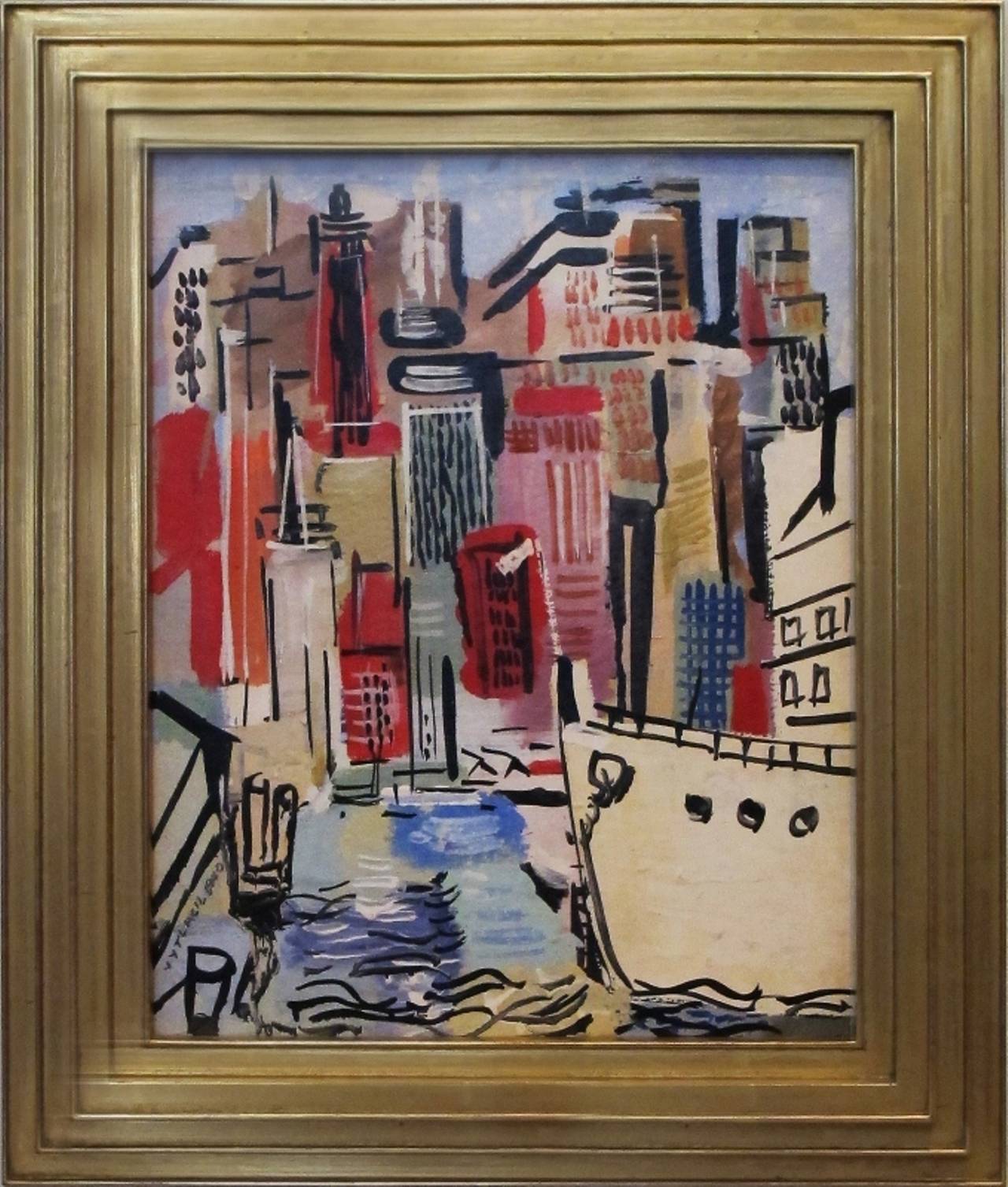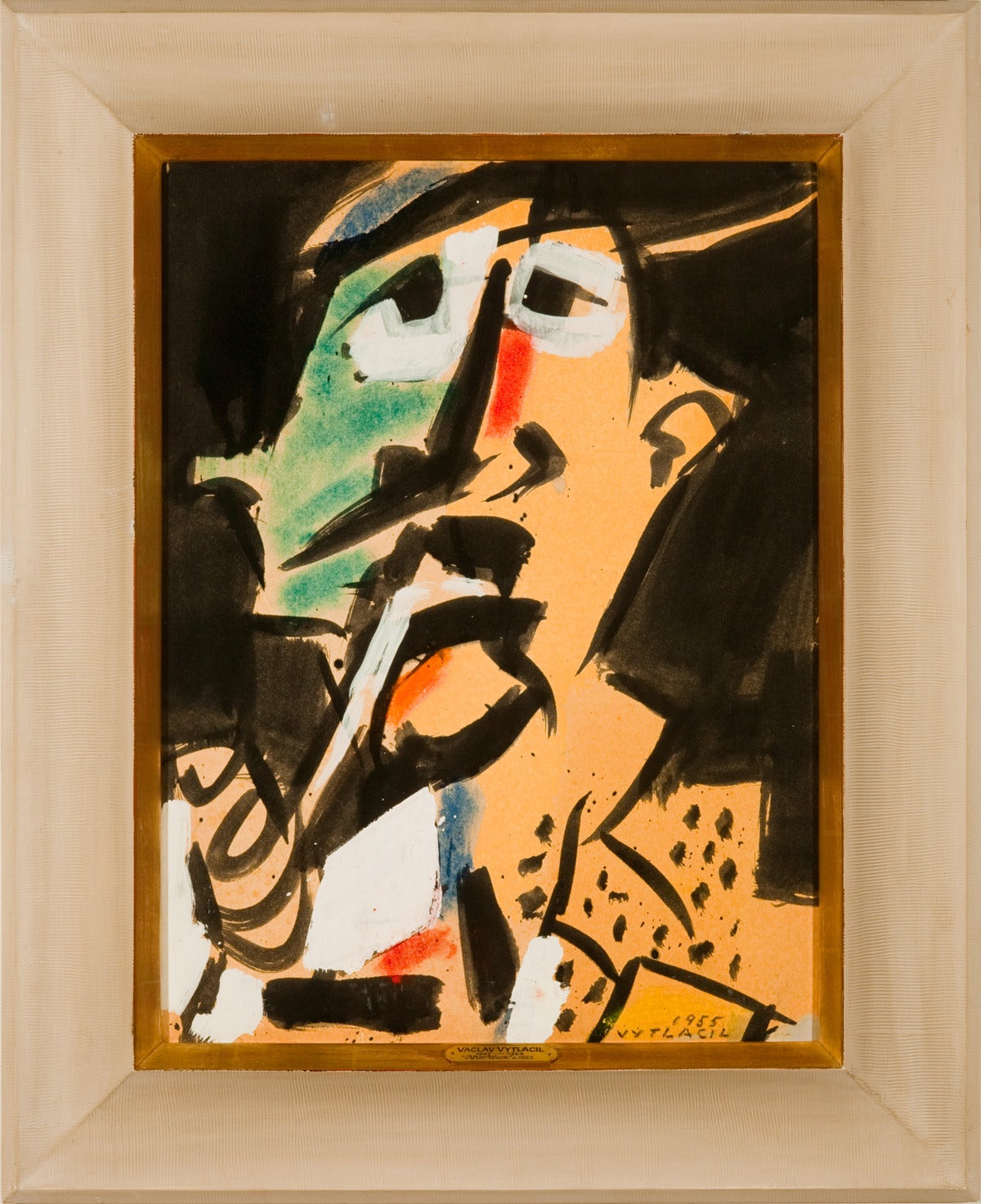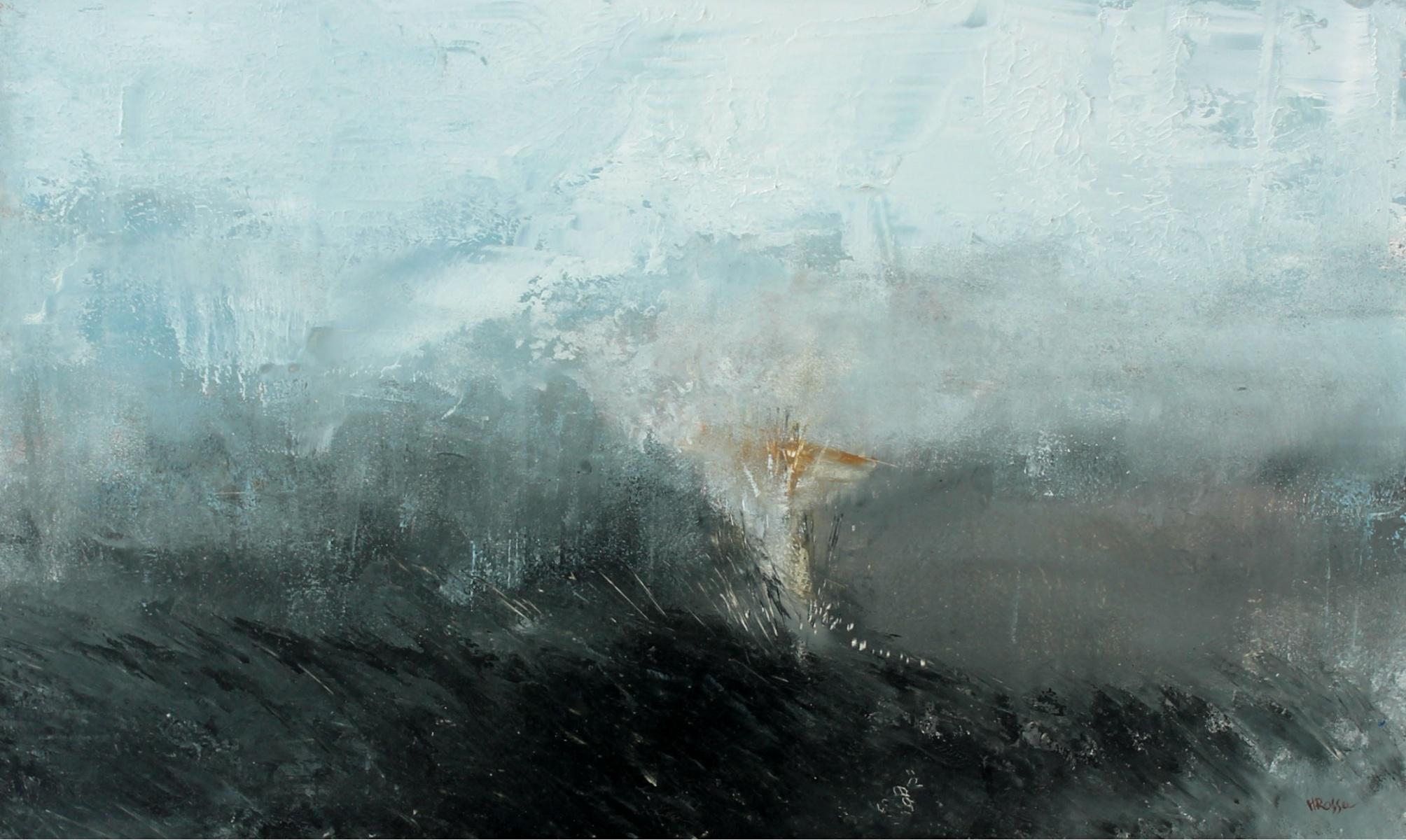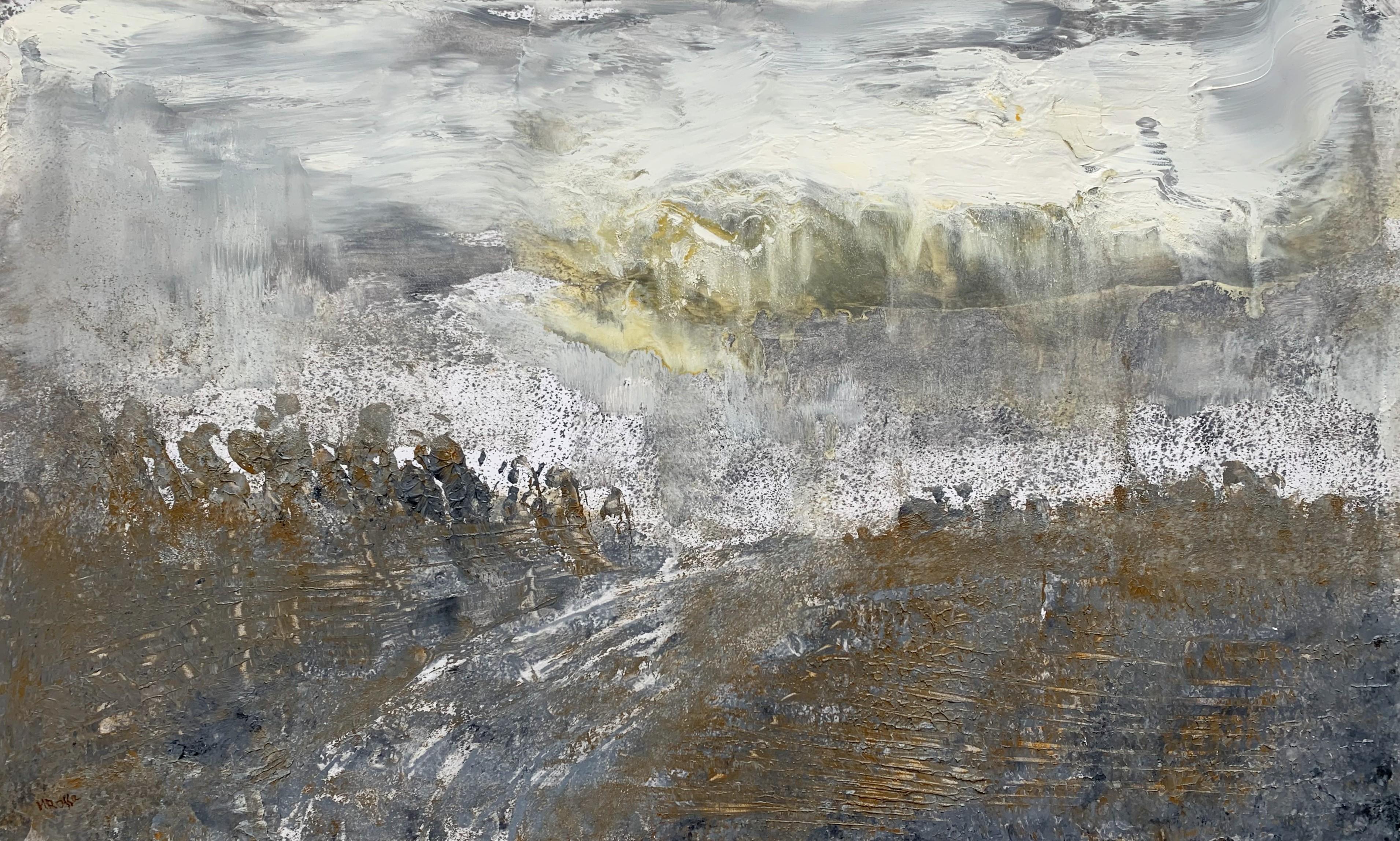Items Similar to "Upper Street" Manierre Dawson, Cubism, Abstract Pastels, Cityscape
Want more images or videos?
Request additional images or videos from the seller
Manierre Dawson"Upper Street" Manierre Dawson, Cubism, Abstract Pastels, Cityscape1912
1912
About the Item
Manierre Dawson
Upper Street, 1912
Oil on board
10 x 15 inches
Provenance:
The artist
Estate of the artist
Private Collection (gift of Lillian Dawson, widow of the artist)
Hollis Taggart Galleries, New York and Stratford Fine Art, New York
Private Collection, 2005
Private Collection, New York, by descent
Literature:
This painting is recorded in the Dawson Record under the heading "1912": "Upper Street, 10 x 14, basswood."
R.J. Ploog, M. Bairstow, A. Boyjian, Manierre Dawson: A Catalogue Raisonné, Jacksonville, 2011, no. 1912.26, p. 189, illustrated.
Chicago-born Manierre Dawson (1887-1969) was a major early American modernist painter — perhaps the Windy City's most progressive spirit. It is generally believed that this civil engineer and self-taught artist achieved a non-objective abstraction with no knowledge of the activities of Kandinsky, whose work Dawson's resembles. He began painting in 1903 or 1904: nature studies that recall Whistler's "nocturnes." By 1906, he painted figural compositions, such as Figures on Pale Blue, that show the obvious influence of Arthur B. Davies. Aspidistra, from the same year, is a minimalist still-life, painted with great precision. The organic curves of the plant have an Art Nouveau elegance. In contrast, Six Flowers in a Vase, painted in 1908, is more two-dimensional.
The artist stated that after graduating in civil engineering from the Illinois Institute of Technology in 1909, when he began working for Holabird and Roche as an architectural designer, he fell under Cézanne's spell: "The following year, . . . I was seriously involved in making pictures that were 'non-objective abstractions,' working from original themes." Prognostic (Milwaukee Art Center), probably Dawson's most famous work, which Gertrude Stein purchased, comes from 1910. Forever in search of stylistic sources, art historians have been struck by the painting's resemblance to what Kandinsky was doing in 1909-1910. Before that time, the avant-garde Russian painter was still working in the Jugendstil-Expressionistic mode. Prognostic, executed in early 1910, apparently pre-dates Kandinsky's famous "improvisations" of the same year, which represent the Russian artist's leap into pure non-objective art. The 1909 "improvisations" are still recognizable as representations of landscape. Susan S. Weininger, in Chicago Modern (2004) adds a possible source for Prognostic: lessons from Arthur Wesley Dow's book Composition (1899), and she quotes from Dawson's notebook: "[he was attempting] "to fix forms by painting or sculpture that have given me an emotion, hoping to find some who reacted as I did to these shapes and colors presented on canvas or in some plastic material. . . . " Furthermore, he stated that Prognostic was one of seven paintings influenced by his engineering and mathematics courses "in the background of coordinates and super-position of differentials. . . ."
In late June of 1910, Dawson made a trip to Europe. There is, unfortunately, no mention in his diary of avant-garde art that he may have seen, however, he did visit Gertrude Stein's residence, where Picasso's 1906 portrait of Stein (Metropolitan Museum of Art) was hanging, along with works by Cézanne, Matisse, and other paintings by Picasso. Surely Matisse's Olive Trees (Metropolitan Museum; Lehman Coll.) would have made an impression on Dawson. Writers assume that Dawson remained unaware of Kandinsky until the Armory Show toured Chicago. The rest of Dawson's story might be called his late period; moreover, he left Chicago in 1914 to settle on a farm in Michigan. Lacking encouragement and occupied with the demands of the farm, Manierre Dawson almost stopped painting. Despite his innovative genius, Dawson "ultimately had little effect on [Chicago's] modernists." In 1968 there was a retrospective of Manierre Dawson's works at the Ringling Museum, Sarasota, Florida, and at the Norton Gallery in Palm Beach. Another followed in 1976 in Chicago's Museum of Contemporary Art.
- Creator:Manierre Dawson (1887-1969, American)
- Creation Year:1912
- Dimensions:Height: 16.5 in (41.91 cm)Width: 21.5 in (54.61 cm)
- Medium:
- Movement & Style:
- Period:
- Condition:
- Gallery Location:New York, NY
- Reference Number:1stDibs: LU1841212878512
About the Seller
5.0
Platinum Seller
These expertly vetted sellers are 1stDibs' most experienced sellers and are rated highest by our customers.
Established in 2021
1stDibs seller since 2022
62 sales on 1stDibs
Typical response time: 1 hour
- ShippingRetrieving quote...Ships From: New York, NY
- Return PolicyA return for this item may be initiated within 3 days of delivery.
More From This SellerView All
- "Harvard vs Yale" Charles Green Shaw, Football, Ivy League Sports, AbstractBy Charles Green ShawLocated in New York, NYCharles Green Shaw Harvard vs. Yale, 1944 Signed and dated on the reverse Oil on canvasboard 9 x 12 inches Provenance: Harvey and Francois Rambach, New Jersey Private Collection, California Washburn Gallery, New York D. Wigmore Fine Art, New York Private Collection, New York Charles Green Shaw, born into a wealthy New York family, began painting when he was in his mid-thirties. A 1914 graduate of Yale, Shaw also completed a year of architectural studies at Columbia University. During the 1920s Shaw enjoyed a successful career as a freelance writer for The New Yorker, Smart Set and Vanity Fair, chronicling the life of the theater and café society. In addition to penning insightful articles, Shaw was a poet, novelist and journalist. In 1927 he began to take a serious interest in art and attended Thomas Hart Benton's class at the Art Students League briefly in New York. He also studied privately with George Luks, who became a good friend. Once he had dedicated himself to non-traditional painting, Shaw's writing ability made him a potent defender of abstract art. After initial study with Benton and Luks, Shaw continued his artistic education in Paris by visiting numerous museums and galleries. From 1930 to 1932 Shaw's paintings evolved from a style imitative of Cubism to one directly inspired by it, though simplified and more purely geometric. Returning to the United States in 1933, Shaw began a series of abstracted cityscapes of skyscrapers he called Manhattan Motifs which evolved into his most famous works, the shaped canvases he called Plastic Polygons. The 1930s were productive years for Shaw. He showed his paintings in numerous group exhibitions, both in New York and abroad, and was also given several one-man exhibitions. Shaw had his first one-man exhibition at the Valentine Dudensing Gallery in New York in 1934, which included 25 Manhattan Motif paintings and 8 abstract works. In the spring of 1935 Shaw was introduced to Albert Gallatin and George L.K. Morris. Gallatin was so impressed with Shaw's work, he broke a policy against solo exhibitions at his museum, the Gallery of Living Art, and offered Shaw an exhibition there. In the summer of 1935 Shaw traveled to Paris with Gallatin and Morris who provided introductions to many great painters. Shaw regularly spent time with John Ferren and Jean Hélion. The following year Gallatin organized an exhibition called Five Contemporary American Concretionists at the Reinhardt Gallery that included Shaw, Ferren, and Morris, Alexander Calder, and Charles Biederman...Category
1940s Abstract Geometric Landscape Paintings
MaterialsOil, Board
- "Untitled, " William Baziotes, Black Modern Abstract Expressionism, SurrealismBy William BaziotesLocated in New York, NYWilliam Baziotes (1912 - 1963) Untitled, circa 1935-1940 Oil on board 14 x 19 3/4 inches Illegible Inscription present to the verso Provenance: Previously from the estate of Consta...Category
1930s Abstract Expressionist Abstract Paintings
MaterialsOil, Board
- "Untitled, " Seymour Fogel, Geometric Abstraction, Texas Hard-EdgeBy Seymour FogelLocated in New York, NYSeymour Fogel Untitled Oil on illustration board construction 10 x 7 1/2 inches Provenance: Estate of the artist Charles and Faith McCracken Larry and Trish Heichel Private Collection Seymour Fogel was born in New York City on August 24, 1911. He studied at the Art Students League and at the National Academy of Design under George Bridgeman and Leon Kroll. When his formal studies were concluded in the early 1930s he served as an assistant to Diego Rivera who was then at work on his controversial Rockefeller Center mural. It was from Rivera that he learned the art of mural painting. Fogel was awarded several mural commissions during the 1930s by both the Works Progress Administration (WPA) and the Treasury Section of Fine Arts, among them his earliest murals at the Abraham Lincoln High School in Brooklyn, New York in 1936, a mural in the WPA Building at the 1939-1940 New York World's Fair, a highly controversial mural at the U.S. Post Office in Safford, Arizona (due to his focus on Apache culture) in 1941 and two murals in what was then the Social Security Building in Washington, D.C., also in 1941. Fogel's artistic circle at this time included Phillip Guston, Ben Shahn, Franz Kline, Rockwell Kent and Willem de Kooning. In 1946 Fogel accepted a teaching position at the University of Texas at Austin and became one of the founding artists of the Texas Modernist Movement. At this time he began to devote himself solely to abstract, non-representational art and executed what many consider to be the very first abstract mural in the State of Texas at the American National Bank in Austin in 1953. He pioneered the use of Ethyl Silicate as a mural medium. Other murals and public works of art done during this time (the late 1940s and 1950s) include the Baptist Student Center at the University of Texas (1949), the Petroleum Club in Houston (1951) and the First Christian Church, also in Houston (1956), whose innovative use of stained glass panels incorporated into the mural won Fogel a Silver Medal from the Architectural League of New York in 1958. Fogel relocated to the Connecticut-New York area in 1959. He continued the Abstract Expressionism he had begun exploring in Texas, and began experimenting with various texturing media for his paintings, the most enduring of which was sand. In 1966 he was awarded a mural at the U.S. Federal Building in Fort Worth, Texas. The work, entitled "The Challenge of Space", was a milestone in his artistic career and ushered in what has been termed the Transcendental/Atavistic period of his art, a style he pursued up to his death in 1984. Painted and raw wood sculpture...Category
Mid-20th Century Abstract Geometric Abstract Paintings
MaterialsOil, Board
- Cronus Dining (Night)By David HareLocated in New York, NYDavid Hare Cronus Dining (Night), 1971 Acrylic, ink, paper collage on paper on board 39 1/2 x 29 5/8 inches “Freedom is what we want,” David Hare boldly stated in 1965, but then he ...Category
1970s Abstract Abstract Paintings
MaterialsInk, Acrylic, Board
- "Midsummer Night" Gerome Kamrowski, Color Field, Abstract ExpressionismBy Gerome KamrowskiLocated in New York, NYGerome Kamrowski Midsummer Night, 1973 Signed upper left Acrylic on canvas 16 x 20 inches Gerome Kamrowski was born in Warren, Minnesota, on January 19, 1914. In 1932 he enrolled in...Category
1970s Abstract Expressionist Abstract Paintings
MaterialsFoam, Mixed Media, Acrylic, Board
- "Pond I, " Alan Fenton, Abstract Expressionism, New York School, Color FieldLocated in New York, NYAlan Fenton (1927 - 2000) Pond I, 1958 Oil on canvas 81 x 90 inches Signed, titled and dated on the reverse Fenton's quiet and contemplative nonobjective paintings and drawings were...Category
1950s Abstract Expressionist Abstract Paintings
MaterialsCanvas, Oil
You May Also Like
- "Fish Cleaners"By Vaclav VytlacilLocated in Lambertville, NJSigned & Dated LR (Highly exhibited) The New York Times, Sunday October 30, 1949 by Howard Devree. "Both as teacher and as painter Vaclav Vytlacil has been a decided force in contem...Category
20th Century Abstract Abstract Paintings
MaterialsOil, Board
- "Lower Manhattan"By Vaclav VytlacilLocated in Lambertville, NJSigned & dated 1940 lower left. Vaclav Vytlacil (1892-1984) He was born to Czechoslovakian parents in 1892 in New York City. Living in Chicago as a youth, he took classes at the S...Category
1940s Abstract Abstract Paintings
MaterialsOil, Board
- "Sea and Sky, Deer Isle"By Mercedes MatterLocated in Lambertville, NJJim’s of Lambertville is proud to offer this artwork by: Best known as a painter of abstract still life and founder of the New York Studio School, Mercedes Matter was also a disting...Category
Mid-20th Century Abstract Abstract Paintings
MaterialsCanvas, Oil, Board
- "After Work"By Vaclav VytlacilLocated in Lambertville, NJJim’s of Lambertville is proud to offer this artwork. Signed lower right Vaclav Vytlacil (1892-1984) He was born to Czechoslovakian parents in 1892 in New York City. Living in C...Category
20th Century Abstract Expressionist Abstract Paintings
MaterialsOil, Board
- Landscape - XXI century, Contemporary Oil & Acrylic Painting, AbstractionBy Monika RossaLocated in Warsaw, PLMONIKA ROSSA studied painting at the University of Arizona, in the Ecole des Beaux Arts in Paris and at the Escuela de Diseno in Barcelona. She practices drawing and easel painting....Category
21st Century and Contemporary Abstract Abstract Paintings
MaterialsOil, Acrylic, Board
- Landscape - XXI century, Contemporary Oil & Acrylic Painting, AbstractionBy Monika RossaLocated in Warsaw, PLMONIKA ROSSA studied painting at the University of Arizona, in the Ecole des Beaux Arts in Paris and at the Escuela de Diseno in Barcelona. She practices drawing and easel painting....Category
21st Century and Contemporary Abstract Abstract Paintings
MaterialsOil, Acrylic, Board





